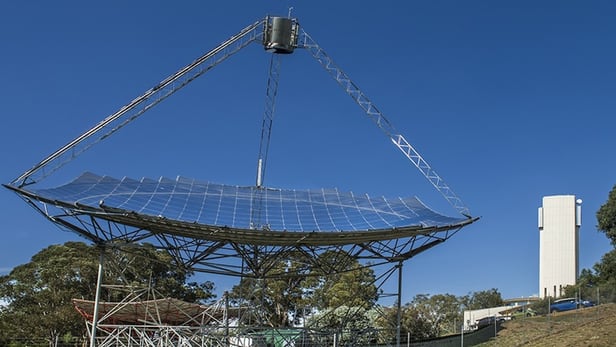Solar thermal record sees 97% conversion of sunlight into steam

Scientists at ANU have set a new record for solar thermal efficiency (Credit: Stuart Hay, ANU)
Australian scientists are no strangers to world records for solar power. Back in 2014, the CSIRO created supercritical steam at the highest temperature and pressure, and in May this year, engineers at UNSW achieved 34.5 percent efficiency in directly converting sunlight to electricity. Now, scientists at the Australian National University (ANU) have managed a new record of 97 percent efficiency for converting sunlight into steam.
Unlike photovoltaic solar panels, which absorb sunlight and directly convert it into electricity, concentrating solar power (CSP) systems reflect sunlight from a wide area and focus it in on a small receiver. As that receiver heats up, water inside turns into steam, which drives a turbine to generate electricity. Rather than storing that power in potentially costly batteries, the thermal energy is stored in molten salts, so that water can be added to create steam (and subsequently electricity) long after the sun's gone down.
The so-called Big Dish at ANU is made up of a concave surface of reflectors, directing sunlight to a receiver suspended at the focal point. A new receiver for the dish, designed and built by the team, was responsible for halving previous losses and achieving the 97 percent conversion.
"When our computer model told us the efficiency that our design was going to achieve, we thought it was alarmingly high," says Dr John Pye, from the ANU Research School of Engineering. "But when we built it and tested it, sure enough, the performance was amazing."
The team describes its receiver design as resembling a top hat, with a wide brim running around the bottom of a narrower cavity that extends upwards. The dish reflects sunlight onto water pipes that wrap around the bottom of the receiver's brim and up into the cavity, heating the water to 500º C (932º F) and turning it into steam. To minimize heat loss, the steam hits that peak temperature at the deepest part of the cavity, so that any heat that is lost can feed back into the pipes around the brim.
With the reflectors focusing the equivalent of about 2,100 suns onto the receiver, the components can actually be damaged if it isn't aligned just right, so the team initially had to use the softer light of the full moon to calibrate the system.
"Ultimately the work in this project is all about reducing the cost of concentrating solar thermal energy," says Pye. "Our aim is to get costs down to 12 cents per kilowatt-hour of electricity, so that this technology will be competitive. This new design could result in a 10 per cent reduction in the cost of solar thermal electricity. I'm optimistic that our technology can play a role in the grid, by helping to provide power at night without fossil fuel power stations running."
The research was presented at the SolarPACES conference last year.
The team discusses the project in the video below.
Source: Australian National University Video: Australian National University/CC BY 3.0 AU
